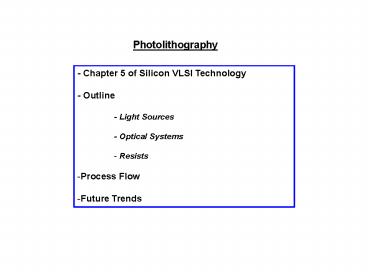Photolithography - PowerPoint PPT Presentation
1 / 17
Title:
Photolithography
Description:
All processing takes place in a cleanroom (class 10 requires no more than 10 ... Post exposure bake. Resist develop. Resist hardbake. Figure 5-31 in text ... – PowerPoint PPT presentation
Number of Views:321
Avg rating:3.0/5.0
Title: Photolithography
1
Photolithography
- - Chapter 5 of Silicon VLSI Technology
- - Outline
- - Light Sources
- - Optical Systems
- Resists
- Process Flow
- Future Trends
2
Overview
- -All processing takes place in a cleanroom (class
10 requires no more than 10 particles gt 1µm every
cubic foot), - The fundamental principles of fabrication are
deposition, etch, doping, - The common link and cornerstone fab process is
photolithography.
-Photolithography defines the minimum feature of
a process and hence the traditional wavelengths
have been in the UV (436nm and 365nm, i-line and
g-line of Hg), -More recently Intel and others
have developed DUV (193nm) and EUV
(lt100nm), -There are about 30 mask layers in a
modern process.
3
Creation of Blue Print in CAD
Layer 2 is a perfect match for layer 1
Complete six layer mask set
4
Writing the Hard Mask
- -Thin (40-80nm) chrome layer deposited on high
quality glass, - Photoresist defines mask pattern, then written by
laser or e-beam, - -Isotropic, wet etch of chrome (thin layer), 4 to
5X larger than actual feature on mask.
5
Light Sources Hg lamps
-Diffraction theory tells us that the smallest
resolvable feature is the same dimension as the
wavelength of the probe (approximately)- trend is
therefore ?, -Traditional source is UV, Hg
(mercury) lamp, with several wavelengths -
g-line 436nm - i-line 365nm, -good for
resolution of features to about 300nm, -optical
power density 100mJcm-2.
6
Light Sources Excimer lasers
-An excimer lasers distinguishing property is
that it has two gas comonents which do not
normally react (e.g. Kr and NF3), -When excited
(via RF discharge), they form KrF, which decays
radiatively in the UV, - KrF 248nm - ArF
193nm, -good for resolution of features beyond
100nm.
-The Nova range from Lambda Physik
(www.lambdaphysik.com)
7
Exposure Systems
Contact
Proximity
Projection
8
The Concept of Step and Repeat
-The exposed area is divided into fields, -Each
field is exposed individually, -This allows the
use of 4-5x masks, and circumvents problems with
trying to align to a large wafer, -Can be
combined with scanning source to reduce
aberrations.
Exposure field
9
Diffraction
-Photolithography requires a system where the
wavelength of light is comparable to the
dimensions of the mask, -Therefore we need to
consider the effects of diffraction
-Using the Huygen construction we can model
diffraction through a small aperture (from figure
5.5), -when the aperture is made even smaller?
10
Image of a Small Aperture
Aperture
Image plane
f
d
Source
Focus lens
Collimating lens
-Diffraction causes a small aperture to imaged as
an Airy disk where Diameter of central maximum
1.22?f / d, Point source is always broadened
unless?
Intensity
1.22?f / d
Displacement
11
Rayleigh Criteria
Angle ?
Aperture d
Two Sources
Two Images
-The two point sources (could be close packed
points on a mask) produce two images which have
the form of Airy disk, -We can resolve them if
the min of one is coincident with the max of the
other (Rayleigh criteria), R 1.22 ? f / d,
(where R is the smallest resolvable feature), Can
show that, R 0.61 ? / n sin ?, (n is usually
1), but we can define sin ? as the numerical
aperture of the system (NA), R 0.61 ? / NA
k1 ? / NA - (5.4) (k1 0.6-0.8, NA 0.5).
12
Depth of Focus (DOF)
-For high resolution then we would like to make
NA large (ie a very large lens/aperture), however
this has a negative effect on the DOF, -First,
how can we define the conditions for DOF?
Resolution
DOF
-In fact we can show (equations 5.5-5.8), DOF
? k2 ?/(NA)2 Where k2 ½.
13
Modulation Transfer Function (MTF)
MTF Imax- Imin / Imax Imin
-MTF is a measure of the contrast of an aerial
pattern, -For well-separated images, MTF
1, -For smaller images, MTFlt1 -In general, MTF
should be gt0.5.
Intensity
Intensity
Displacement
Displacement
14
Energy to Clear (Qf)
Q0
Qf
Q0
Qf
-The Photo-process is defined using Qf and Q0,
energy to clear and energy at start of
develop, -the contrast is then given by ? 1
/ log10 Qf/Q0 Typical contrast is 2 to 3, with
Q060mJ cm-2, and Qf 100mJ cm-2.
15
Absorption in Photoresist
-As light passes through the resist, it changes
the resists molecular chemistry, -This absorption
process results in a decrease in the optical
intensity such that I I0 e -?z, where I is
the intensity, z is depth and ? is the
absorption coefficient. -This would be expected
to limit the useful thickness of resist, however,
a photo-bleaching process in resists limits
reduces ? with exposure, resulting in a uniform
exposure intensity.
-The variation in refractive index between he
resist and the substrate can cause considerable
reflection of the incident light, -This increases
the effective optical dose, but also creates an
optical cavity, -Without considerable care in the
process the ideal geometry can be considerably
altered.
16
Phase Shifting
Mask pattern
Near field (?near)
Far field (?far)
Intensity at resist (?far2)
-The introduction of a 180o phase shift improves
the resolution of small features, -In practice
this is a complicated process relying on
simulation.
17
The Complete Process Reviewed
Surface Cleaning and Baking
Adhesion promoter application (HMDS)
Resist Application
Pre exposure bake
Wafer alignment and exposure
Post exposure bake
Resist develop
Resist hardbake
Figure 5-31 in text































